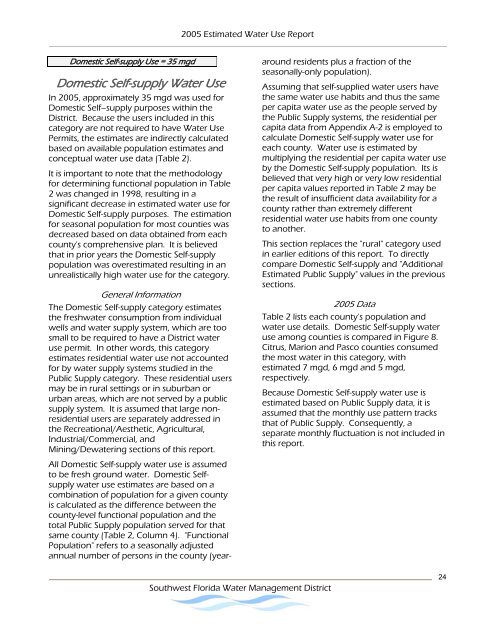Estimated Water Use Report - Southwest Florida Water ...
Estimated Water Use Report - Southwest Florida Water ...
Estimated Water Use Report - Southwest Florida Water ...
You also want an ePaper? Increase the reach of your titles
YUMPU automatically turns print PDFs into web optimized ePapers that Google loves.
2005 <strong>Estimated</strong> <strong>Water</strong> <strong>Use</strong> <strong>Report</strong><br />
Domestic Self-supply <strong>Use</strong> = 35 mgd<br />
Domestic Self-supply <strong>Water</strong> <strong>Use</strong><br />
In 2005, approximately 35 mgd was used for<br />
Domestic Self–supply purposes within the<br />
District. Because the users included in this<br />
category are not required to have <strong>Water</strong> <strong>Use</strong><br />
Permits, the estimates are indirectly calculated<br />
based on available population estimates and<br />
conceptual water use data (Table 2).<br />
It is important to note that the methodology<br />
for determining functional population in Table<br />
2 was changed in 1998, resulting in a<br />
significant decrease in estimated water use for<br />
Domestic Self-supply purposes. The estimation<br />
for seasonal population for most counties was<br />
decreased based on data obtained from each<br />
county's comprehensive plan. It is believed<br />
that in prior years the Domestic Self-supply<br />
population was overestimated resulting in an<br />
unrealistically high water use for the category.<br />
General Information<br />
The Domestic Self-supply category estimates<br />
the freshwater consumption from individual<br />
wells and water supply system, which are too<br />
small to be required to have a District water<br />
use permit. In other words, this category<br />
estimates residential water use not accounted<br />
for by water supply systems studied in the<br />
Public Supply category. These residential users<br />
may be in rural settings or in suburban or<br />
urban areas, which are not served by a public<br />
supply system. It is assumed that large nonresidential<br />
users are separately addressed in<br />
the Recreational/Aesthetic, Agricultural,<br />
Industrial/Commercial, and<br />
Mining/Dewatering sections of this report.<br />
All Domestic Self-supply water use is assumed<br />
to be fresh ground water. Domestic Selfsupply<br />
water use estimates are based on a<br />
combination of population for a given county<br />
is calculated as the difference between the<br />
county-level functional population and the<br />
total Public Supply population served for that<br />
same county (Table 2, Column 4). "Functional<br />
Population" refers to a seasonally adjusted<br />
annual number of persons in the county (yeararound<br />
residents plus a fraction of the<br />
seasonally-only population).<br />
Assuming that self-supplied water users have<br />
the same water use habits and thus the same<br />
per capita water use as the people served by<br />
the Public Supply systems, the residential per<br />
capita data from Appendix A-2 is employed to<br />
calculate Domestic Self-supply water use for<br />
each county. <strong>Water</strong> use is estimated by<br />
multiplying the residential per capita water use<br />
by the Domestic Self-supply population. Its is<br />
believed that very high or very low residential<br />
per capita values reported in Table 2 may be<br />
the result of insufficient data availability for a<br />
county rather than extremely different<br />
residential water use habits from one county<br />
to another.<br />
This section replaces the "rural" category used<br />
in earlier editions of this report. To directly<br />
compare Domestic Self-supply and "Additional<br />
<strong>Estimated</strong> Public Supply" values in the previous<br />
sections.<br />
2005 Data<br />
Table 2 lists each county's population and<br />
water use details. Domestic Self-supply water<br />
use among counties is compared in Figure 8.<br />
Citrus, Marion and Pasco counties consumed<br />
the most water in this category, with<br />
estimated 7 mgd, 6 mgd and 5 mgd,<br />
respectively.<br />
Because Domestic Self-supply water use is<br />
estimated based on Public Supply data, it is<br />
assumed that the monthly use pattern tracks<br />
that of Public Supply. Consequently, a<br />
separate monthly fluctuation is not included in<br />
this report.<br />
<strong>Southwest</strong> <strong>Florida</strong> <strong>Water</strong> Management District<br />
24
















